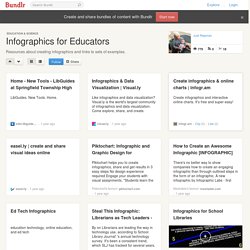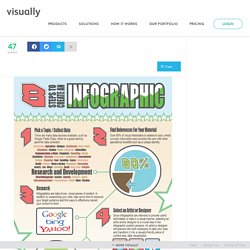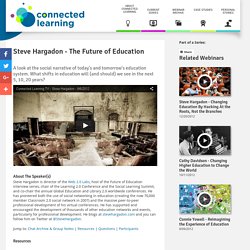

Digital Footprint Resources for FRIT 7234. Creating Classrooms We Need: 8 Ways Into Inquiry Learning. If kids can access information from sources other than school, and if school is no longer the only place where information lives, what, then happens to the role of this institution?

“Our whole reason for showing up for school has changed, but infrastructure has stayed behind,” said Diana Laufenberg, who taught history at the progressive public school Science Leadership Academy for many years. Laufenberg provided some insight into how she guided students to find their own learning paths at school, and enumerated some of these ideas at SXSWEdu last week. 1. BE FLEXIBLE. The less educators try to control what kids learn, the more students’ voices will be heard and, eventually, their ability to drive their own learning. Laufenberg recalled a group of tenacious students who continued to ask permission to focus their video project on the subject of drugs, despite her repeated objections. 2. Laufenberg’s answer: Get them curious enough in the subject to do research on their own. 3. 4. Creating Classrooms We Need: 8 Ways Into Inquiry Learning. Silvia Tolisano- Langwitches Blog.
There are, no doubt, many technophobes (among educators and in general) out there.

Technophobia is defined by The Free Dictionary as: Related Redefining My Learning Silvana Meneghini and I work as Academic Technology Coordinators at Graded, the American School of São Paulo. " A flashlight in the fog of technology integration", initially the title of a conference workshop proposal, quickly developed into the desire of creating a framework to guide and coach teachers based on… 15. 21st Century Information Fluency.
1. What is Digital Information Fluency (DIF)? 2. How is DIF different from Print Information Literacy? 3. How is DIF different from Information Literacy? Social Media Changing Learning: Eduardo Briceno at TEDxManhattanBeach. Infographics for Educators. We live in a world of quick consumption, bite-size morsels of information, and visualizations of just about everything.

All of this has become boiled down into the uber-popular infographic. They pop up from time to time on Edudemic and I often have a tough time determining if I should actually run versus another. I’ve been saving up all of my favorite infographics for a post just like this one. An all-in-one no-extra-clicking-necessary post where you can scroll for miles and have a never-ending stream of visualized goodness. I picked each infographic based on the topic, breadth of information, and overall worth.
The phrase ‘sum is greater than its parts’ comes to mind as each of these 10 infographics is useful in its own right… but altogether they’re downright overwhelmingly helpful. The Public Thinks Laptops Shouldn’t Be Allowed in Class Until High School The Internet: A Decade Later The growth of the internet in the last 10 years is staggering. Will Mobile Kill YouTube? 8 Steps to Create an Infographic. 1.

Pick a Topic / Collect Data There are many data sources available, such as Google public data, which is a great starting point for data collection. Advertising-Agriculture-Antiques-Architecture-Arts & Crafts-Automotive-Aviation-Books-Chemicals-Collectibles- Communications & Media-Computers-Consulting-Design-Disabilities-Education-Electronics-Employment-Entertainment- Fashion-Financing-Food-Gambling-Games-Government-Health-Hobbies-Home & Garden-Hospitality-Information-Jewelry- Jewelry-Law-Music-Parenting-Retail-Real Estate-Religion RESEARCH AND DEVELOPMENT Retail Management-Science-Security-Software-Sports-Telecommunication-Transportation-Travel-Video-Weather. 2. Find References for Your Material Over 80% of visual is related to color, which conveys information and provides the user with other operational benefits such as a unique identity. 3.
Research Infographics are data driven, visual pieces of content. SHARE YOUR KNOWLEDGE WITH THE WORLD: t: f: visual.ly: P. Best Websites for Teaching & Learning. Best Websites for Teaching & Learning honors websites, tools, and resources of exceptional value to inquiry-based teaching and learning.

Sites recognized foster the qualities of innovation, creativity, active participation, and collaboration. They are free, web-based sites that are user friendly and encourage a community of learners to explore and discover. The Landmark Websites are honored due to their exemplary histories of authoritative, dynamic content and curricular relevance. How to Use Google Search More Effectively [INFOGRAPHIC] Eli Pariser: Beware online "filter bubbles". Great Teaching Means Letting Go. Great Teaching Means Letting Go by Grant Wiggins, Ed.D, Authentic Education My greatest learning as a teacher came on the soccer field.

We had been working for a few weeks on the same key ‘moves’ on the field related to creating ‘space’. After a few practices, the team looked good in the drills – they’ve got it! Next two games? There are two vital lessons here about learning: Transfer is the bottom-line goal of all learning, not scripted behavior.Transfer means that a learner can draw upon and apply from allof what was learned, as the situation warrants, not just do one move at a time in response to a prompt. In a word: autonomy. Put negatively, the more coaches and teachers prompt/remind/scaffold, over and over, without a deliberate and explicit plan for release of responsibility, the more students will flounder in situations demanding autonomy. Everywhere I go I see way too much scaffolded and prompted teaching – through twelfth grade. But, Grant – surely with little kids… No!
1. Chris Lehmann - Inquiry: The Very First Step In the Process of Learning. Chris Lehmann is the founding principal of the Science Leadership Academy (SLA) in Philadelphia, Pennsylvania.

In November of 2012, Chris was named one of Dell's #Inspire100 - one of the 100 people changing the world using Social Media. In April of 2012, Chris won the Lindback Award for Excellence in Principal Leadership in the School District of Philadelphia. In September of 2011, Chris was honored by the White House as a Champion of Change for his work in education reform.
SLA is built on the notion that inquiry is the very first step in the process of learning. Developed in partnership with The Franklin Institute and its commitment to inquiry-based science, SLA provides a rigorous, college-preparatory curriculum with a focus on science, technology, mathematics and entrepreneurship. Jump to: Resources | Chat & Group Notes | Questions | Participants. Steve Hargadon - The Future of Education. Steve Hargadon is director of the Web 2.0 Labs, host of the Future of Education interview series, chair of the Learning 2.0 Conference and the Social Learning Summit, and co-chair the annual Global Education and Library 2.0 worldwide conferences.

He has pioneered both the use of social networking in education (creating the now 70,000 member Classroom 2.0 social network in 2007) and the massive peer-to-peer professional development of his virtual conferences. He has supported and encouraged the development of thousands of other education networks and events, particularly for professional development. He blogs at stevehargadon.com and you can follow him on Twitter at @SteveHargadon. Jump to: Chat Archive & Group Notes | Resources | Questions | Participants. The Best K-12 Education Technology Blogs. If it takes a village to raise a child, how many people does it take to train an educator?

It’s hard to say, but 50 helping hands seems like a good place to start. In the spirit of community, collaboration and information sharing, EdTech: Focus on K–12 has rounded up 50 ed-tech blogs that we deem must-reads for the K–12 community. We launched our first Must-Read IT list last year to great response so we hope that you all enjoy this year's batch of blogs as well. These blogs are a mix of voices and include blogs authored by teachers, administrators and technology vendors. They share real-world classroom experiences, offer inspiration and distribute valuable best practices. This list was built in part by you, our readers.
Without further ado, here is the 2013 Honor Roll: Purely Paperless We are living in a world that is becoming increasingly digital, and Montana elementary school teacher Kate Peila is a paperless girl. Read the blog: purelypaperless.blogspot.com The Daring Librarian EdReach.